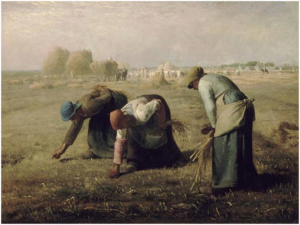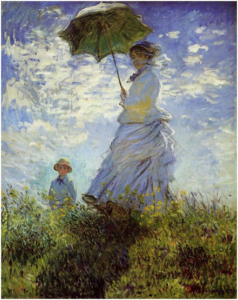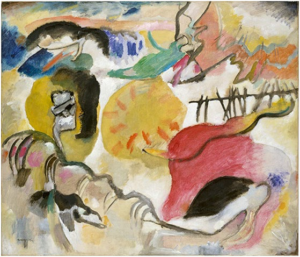During the last 2 decades, the medical research underwent a gradual transition from purely quantitative research (post-positivist) to endorse qualitative research (interpretivist) paradigm. This article tries to shed a light on this transition and use fine art examples as analogy. For the sake of clarification it is important to explain some of the terms used in this article for readers whom their interest might be out of the scope of qualitative research or fine art.
For centuries art tradition aimed depicting the details of events, even mythical events in exceptional clarity and preciseness, in another word making the art work believable. The epitome of this endeavour could be represented by the art style of Realism (Figure 1).
Figure 1: Realistic Painting (Jean-Francois Millet, 1814-1875, “The Gleaners,” 1857), Musée d’Orsay, Paris.

Realist painters were more concerned about real life events, directing their attention toward marginalised people. Realism reflects a philosophical rather than artistic style. It wanted to show the true nature of reality no matter beautiful or ugly, dark or bright. It must reflect what is out there not what we want to see.1
Realism in this aspect has its similarities to medical research. Researchers in medical field strive to deal with their research findings in objective way and deal with individuals in health and disease with no presumptions. This is why randomised selection from the population to study a given health phenomenon is essential for the objectiveness of the research.
Realism as a philosophical movement applies to art as it applies to science, except in one aspect. Medicine adopts critical realism, or what has been considered synonym for post-positivism. Positivism states that the purpose of science is simply to stick to what we can observe and measure,2 which is true for widely adopted quantitative research in medicine. Quantitative medical research deals with biological facts through numbers, measurements and statistical facts, which govern clinical knowledge and direct the path of treatment.
However, medical research is more toward post-positivism (critical realism) than pure positivism. Post-positivism is a philosophical stance acknowledges that observations could be erroneous and theories are revisable. Scientists, however, should ensure that their observation must be verifiable, reproducible following specific procedures.2 This could reflect the main difference between research in medicine and physics.
Medical researchers are aware of the complexity of biological system, imperfections of statistically dependent methodologies and expected procedural errors. This supports the argument toward the fact that mathematics is unable to explain certain phenomena in economics, psychology and biology.3 Despite this fact, medical researchers still rely in the vast majority of their findings on quantitative studies. Only statistical analysis is their proof of reality of a given phenomenon.
Since the 80s of the 20th century there has been growing trend in medicine to embrace patients’ values and quality of life (QoL).4,5 This led to the development of QoL research, which aimed to deal with health facts from different point of view. Despite it is difficult to find an artistic style or movement that can describe this medical research attitude, it is possible, in some ways, to consider impressionism in its revolution a suitable counter artistic representative to QoL research. In impressionism artists remained honest to the figurative tradition as they depicted the outside reality. They took their canvas outside and performed their paintings outside their studios. They became freer in expressing their understanding of light, colours and the outer environment to be closer to their direct feelings as they paint (Figure 2).6 As in QoL research, impressionist artists had their subjective input toward the outer world reality.
This, however, did not shift medical facts from its positivist position. Even when medical research moved toward subjective (patients side) in evaluating a given health phenomenon, it applied psychometric theory to quantify subjective outcome.7 This is why some researchers argued that QoL is not the suitable term for this field of research, and it should be termed as subjective health outcome measure.8
There are aspects in human life that cannot be measured or it is difficult to comprehend based on numbers and statistical significances. If the medical researcher wants to understand patient’s experience, the meaning of health problem to the patient or their interpretation to their health experience, the researcher needs to embrace an interpretive approach. Otherwise they might miss important opportunities to improve their ability to help the patient through their journey through different health problems and challenges.
Interpretive (qualitative) medical research aims to answer questions cannot be answered by numbers, rankings or statistical values. It is a different research paradigm, which relies completely on human interpretation toward their health problems.9,10
Complete reliance on personal interpretation toward a given phenomenon can be exemplified by using abstract art as analogy. In abstract paintings each spectator has their interpretation toward the painting. These interpretations might be completely different, despite they are dealing with the same painting. There is no tree to say this green field within the canvas is a forest. Since there is no figurative representation of the outer world reality,11 it is difficult to predict the spectator’s view of the painting (Figure 3).
Figure 2: Impressionist Painting, Woman with Parsol, Madam Monet and her Son 1875, Claud Monet (1840- 1926), Collection of Mr. and Mrs. Paul Mellon.

Figure 3: Abstract Painting, Garden of Love 1912, Wassily Kandinsky 1866-1944, Metropolitan Museum of Art, New York.

The same applies a given health phenomenon where each individual might comprehend, view or feel it in a different way. Patient’s view and/or feelings are important aspects of any disease. In a qualitative study done by the author, the data showed a clear gap between patient and physician understanding toward blow-out fractures of the orbit. Table 1 gives an insight how patients, differently, perceive symptoms of this type of trauma than the physician.12
| Table 1: Representing the Gap between Patient and Physician Understanding Toward Blow-Out Fractures of the Orbit. |
| The biomedical clinical concept |
Patient’s interpretation |
| Blow-out fracture (orbital wall fracture) |
Eye ball injury (injury to the eye) |
| Diplopia (double vision) |
Inability to see |
| Enophthalmos |
Sinking of the eye in the head |
| Infra orbital paraesthesia |
Loosening/knocked teeth |
| Surgery (to the orbit) |
Surgery in the eye |
Understanding this fact might help clinicians to approach disease management in more effective way. It improves patient-clinician communication. In addition, there is important interaction between the outcome of a disease and the way patient understands or deal with.12 On this basis qualitative research started to gain popularity in the last decade in medical field with valuable input in medical knowledge.
CONCLUSION
The tendency for medical research to move toward the interpretivist stance might reflect the awareness of medical researchers toward the imperfections of quantitative (post-positivist) research. It also reflects the need for more holistic approach in health care.








